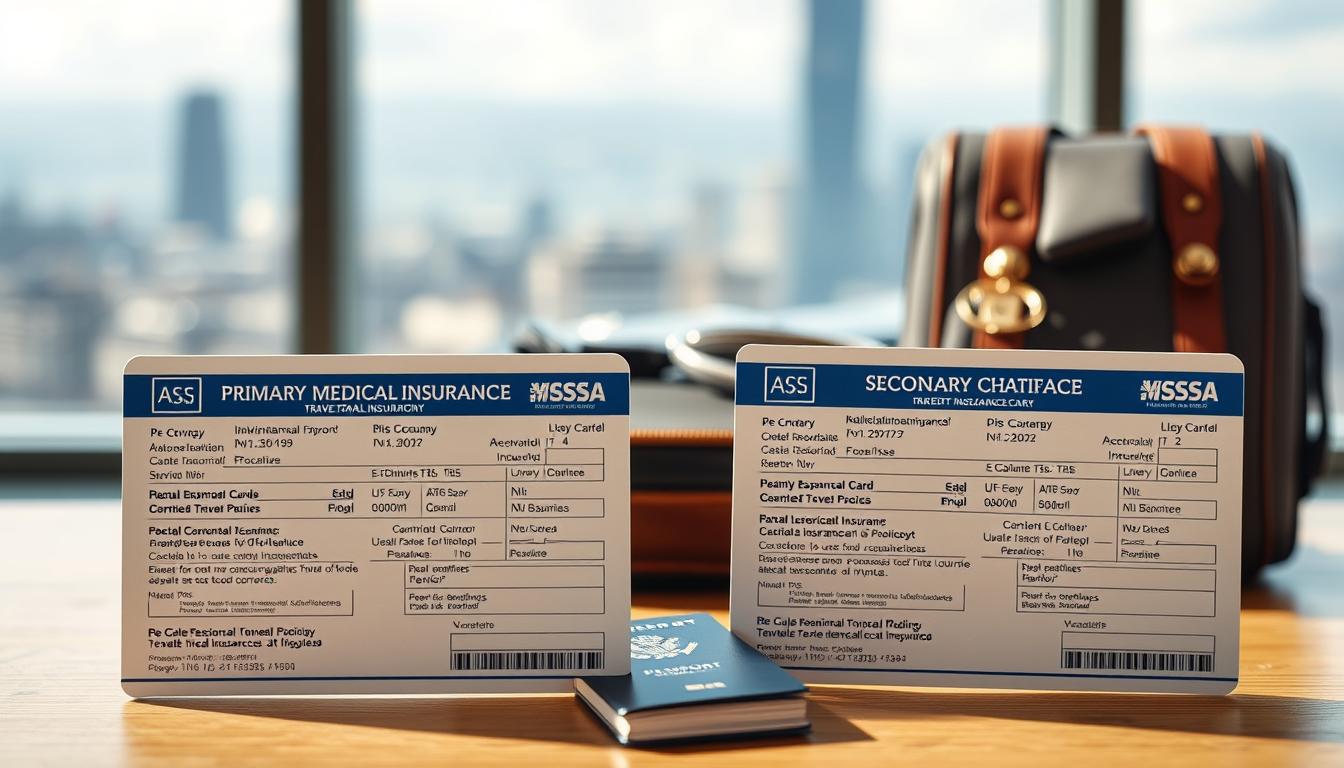Picture this: You’re exploring a bustling market overseas when sudden stomach pain hits. Without protection, a hospital visit could drain your savings. That’s where travel medical insurance steps in—it’s your financial safety net when health surprises strike abroad.
This coverage isn’t just paperwork—it connects you to global experts who handle emergencies 24/7. Companies like IMG specialize in guiding travelers through foreign healthcare systems, so you’re never alone. Whether it’s a broken bone or unexpected illness, these plans turn chaos into calm.
We’ll break down how this safety net works, why terms like “coverage limits” matter, and how to choose smart protection. You’ll also discover how top providers blend affordability with reliability, letting you focus on adventures instead of “what-ifs.”
Ready to travel confidently? Let’s explore how the right plan becomes your invisible travel companion.
Overview of Global Travel Medical Insurance
Imagine needing urgent care in a country where your regular health plan doesn’t work. Global medical protection bridges this gap, offering emergency care access across 190+ countries. Leaders like GeoBlue connect you to vetted hospitals through app-based tools, while Allianz provides 24/7 multilingual support—proving why 73% of travelers prioritize this safeguard.
| Provider | Key Feature | Best For |
|---|---|---|
| GeoBlue | Direct billing with global hospitals | Long-term explorers |
| Allianz | Customizable trip lengths | Short-term adventurers |
We’ve seen clients use these as smart supplements to employer benefits. One family avoided $12,000 in bills after a Bali food poisoning incident—their primary plan covered nothing abroad. International health solutions also handle prescription refills and telehealth consults, letting you focus on experiences instead of paperwork.
Later sections will decode policy fine print and claim processes. For now, remember: the right protection turns “What if?” into “We’ve got this.”
Travel Medical Insurance Coverage: What It Is and Why It Matters
You’re sipping coffee in Paris when a bike collision sends you to a clinic. Your U.S. health plan might not cover that bill. This is where specialized international health protection steps in—a short-term safety net for unexpected injuries or illnesses abroad.
These plans fill gaps left by employer or government benefits. For example, IMG’s policies handle everything from ER visits to prescription refills overseas. Unlike standard domestic options, they prioritize 24/7 multilingual support and direct payments to foreign hospitals.
Why does this matter? Three reasons:
- Foreign clinics often require upfront payment without protection
- Evacuation to quality care can cost over $100,000
- Domestic policies rarely include translation services or local referrals
We’ve helped group travelers save thousands by pairing these plans with existing coverage. One client avoided $8,500 in Costa Rica after a snorkeling accident—their primary insurance wouldn’t cover “high-risk” activities.
Understanding these differences isn’t just smart—it’s essential. The right plan turns potential disasters into manageable hiccups, letting you explore with confidence.
Key Benefits and the Safety Net for Global Travelers
Lost in the Alps with a sprained ankle? Help arrives via your phone—no cash needed. This is the safety net modern explorers rely on, transforming panic into practical solutions when health hiccups strike.
Top-tier plans deliver three game-changing advantages. First: 24/7 emergency teams handle everything from hospital referrals to prescription translations. IMG’s multilingual specialists once guided a client through Tokyo’s healthcare maze in under 90 minutes—saving $3,000 in potential fees.
Second, you avoid draining savings accounts. Network partnerships mean clinics bill providers directly, slashing upfront costs. We’ve seen families bypass $15,000 charges for emergency surgeries in Costa Rica this way.
Finally, stress reduction. Knowing experts coordinate care lets you focus on recovery—not paperwork. One traveler’s kidney infection in Morocco became manageable through real-time telehealth consults with U.S. doctors.
These layers of support create something priceless: peace mind. Whether navigating language barriers or unfamiliar medical systems, your backup team stays on call. That’s how smart protection turns “I’m stranded” into “I’m covered”—wherever adventure leads.
Medical Evacuation and Emergency Assistance Explained
You’re hiking through Costa Rica’s rainforest when a venomous snake strikes. Local clinics lack antivenom—this is when evacuation services become lifesavers. Teams like IMG’s spring into action, arranging air transport to equipped facilities within hours.
- Emergency triggers: Life-threatening injuries, unavailable treatments, or natural disasters
- 24/7 coordination with air ambulances and specialty hospitals
- Direct billing so you avoid six-figure transport fees
| Provider | Evacuation Process | Key Benefit |
|---|---|---|
| IMG | Partners with AirMed International | Guaranteed bed-to-bed transfers |
| Allianz | Uses Global Rescue networks | GPS tracking for remote pickups |
These systems shine in hard-to-reach zones. A client’s heart attack on a Greek island became manageable when Allianz chartered a helicopter to Athens. No upfront payments. No language barriers.
Dedicated assistance squads handle logistics so you focus on recovery. Whether it’s rerouting flights for family members or securing ICU beds abroad, they turn chaos into clear next steps. That’s how modern protection keeps adventurers safe—even when the unexpected strikes.
Key Features of Reliable Travel Insurance Plans
Stranded in Thailand with a fever, you reach for your phone—help is one click away. Top-tier protection plans shine here, offering digital tools that turn chaos into calm. Let’s unpack what makes these safeguards essential.
- Instant claim filing through provider apps
- 24/7 emergency teams fluent in local languages
- Virtual doctor visits via telehealth platforms
| Provider | Standout Feature | Ideal Use |
|---|---|---|
| IMG | Same-day prescription delivery | Remote destinations |
| GeoBlue | Direct hospital payments | Cost predictability |
| Allianz | Activity-specific upgrades | Adventure trips |
Comparing options? Use the “see plans” buttons on provider sites. These reveal coverage limits, exclusions, and pricing tiers side-by-side. We’ve watched clients save hours by filtering plans based on trip duration and activity risks.
Transparency matters. Reputable companies list benefits clearly—no buried clauses. One family avoided denied claims in Peru by choosing a plan with explicit altitude sickness coverage. Your perfect match exists; it’s about matching features to your itinerary’s unique needs.
Navigating Policy Terms and State-Specific Regulations
Your new protection plan arrives—but did you spot the clause about pre-existing conditions in Texas versus Florida? Policy details vary by state, and missing these nuances could leave you with surprise bills. IMG’s data reveals that 32% of denied claims trace back to overlooked regional rules.
Why does your home state matter? Local laws shape everything from benefit caps to approval timelines. For example:
- California requires faster claim responses than most states
- New York mandates coverage for telehealth consults
- Florida allows shorter appeal windows for denied cases
Always locate your provider’s claims center contact early—it’s often buried in policy documents. We recommend highlighting billing addresses and submission deadlines before your trip. One client saved $2,300 by filing through Arizona’s designated portal instead of the generic form.
Use “get quote” tools to compare how different states handle deductibles or emergency care. Reputable sites let you filter by residency to see exact terms. Remember: Your perfect plan combines broad protection with compliance to your state’s unique playbook. A few minutes reviewing these details now prevents financial headaches later.
Comparing Primary Versus Secondary Insurance Coverage
What happens when your domestic health plan meets foreign hospital bills? This insurance cover puzzle trips up many globetrotters. Let’s simplify how primary and secondary protection layers work together abroad.

Primary plans pay first—like your employer’s benefits. Secondary options (like IMG’s) step in after, covering eligible leftover costs. Think of it as tag-team financial defense. A traveler in Spain with a $1,000 broken wrist bill would first use their primary plan. If it covers $800, their secondary international travel medical plan handles the remaining $200.
Why choose secondary support? Three smart reasons:
- Avoid upfront payments at foreign clinics
- Fill gaps when primary benefits fall short
- Simplify claims through coordinated provider systems
| Coverage Type | Payment Order | Best For |
|---|---|---|
| Primary | First responder | Basic domestic benefits |
| Secondary | Cleanup crew | Global explorers |
IMG’s process shows this teamwork in action. Clients submit receipts to both insurers. Their team coordinates with your primary provider, often handling paperwork so you don’t juggle multiple claims.
Understanding this dance prevents financial missteps. Pairing a travel medical plan with existing benefits creates seamless protection—letting you focus on passport stamps instead of payment gaps.
Ideal Candidates for International Travel Medical Insurance
Your cousin from Italy plans her first U.S. visit—then twists an ankle at Yellowstone. Without the right safeguards, this mishap could derail her trip. Certain globetrotters benefit most from specialized international travel protection, especially when local healthcare systems feel unfamiliar.
Vacationers and Overseas Relatives
Leisure travelers and visiting family members often lack local health networks. Imagine navigating Tokyo’s clinics with limited Japanese. Providers like IMG offer translated directories and direct billing—critical when your aunt needs urgent care in Miami. One client’s mother avoided $4,200 in out-of-pocket costs after a fall in Chicago thanks to pre-negotiated hospital rates.
Business Travelers and Global Students
Frequent flyers and study-abroad scholars face unique risks. A sales exec in Mexico City contracts food poisoning before a keynote. A student in Barcelona needs appendectomy care. Tailored plans provide:
- Fast-track claims for time-sensitive needs
- Multilingual support for prescription translations
- Mental health resources during extended stays
| Traveler Type | Key Needs | Provider Solutions |
|---|---|---|
| Vacationers | Emergency care access | IMG’s 24/7 nurse hotline |
| Students | Long-term coverage | GeoBlue’s semester-length plans |
These travel resources transform stressful scenarios into manageable fixes. Whether it’s coordinating specialist referrals or simplifying pharmacy visits, the right support keeps adventures on track.
How to Evaluate Medical Claims and Reimbursement Processes
You’re handed a foreign hospital bill after treating a sprained wrist—now what? Navigating reimbursement doesn’t have to feel like deciphering hieroglyphics. With IMG reporting that 89% of successful claims start with proper documentation, preparation is your golden ticket.
Effective Claim Submission Tips
Start by snapping photos of every receipt and doctor’s note. Allianz’s data shows claims with itemized bills get processed 40% faster. Follow this checklist:
- Submit forms within 30 days of treatment
- Include translated diagnosis codes (ask clinic staff)
- Highlight medical benefits your plan covers upfront
| Provider | Required Documents | Processing Time |
|---|---|---|
| IMG | Itemized bills + passport copy | 7-10 business days |
| Allianz | Claim form + payment proof | 5-7 business days |
Understanding Coverage Limitations and Exclusions
Not all expenses qualify. Trip cancellation protection, for example, usually excludes weather-related disruptions if warnings existed pre-booking. Watch for these common gaps:
- Pre-existing conditions (unless declared)
- Adventure sports injuries without upgrades
- Non-emergency dental work
We’ve seen clients recover $12,000+ by matching bills to their plan’s medical benefits list first. One family avoided denied claims in Mexico by confirming their policy covered snorkeling mishaps. Knowledge isn’t just power here—it’s cash back in your pocket.
Incorporating Additional Travel Protection Benefits
Your flight gets delayed, causing missed reservations for a safari tour. While health emergencies are priority one, modern plans offer extra benefits that safeguard both your adventures and peace of mind. Think of these as bonus layers shielding your plans from life’s curveballs.
- Trip cancellation reimbursements for non-refundable bookings
- Rental car collision waivers during road trips
- 24/7 concierge access for last-minute hotel rebookings
Allianz clients recently recouped $2,800 after a family reunion cruise got canceled. Their plan’s trip protection covered flights and prepaid excursions automatically. Others use IMG’s lost luggage assistance to replace essentials within hours—no receipts required.
Some plans even watch your back at home. GeoBlue’s post-trip support helps with:
- Prescription refills using foreign doctor notes
- Emergency home repairs if pipes freeze while you’re away
- Mental health check-ins after stressful incidents abroad
These benefits transform basic safeguards into full-spectrum support. Whether it’s rerouting a delayed baggage delivery or coordinating pet care during extended stays, the right add-ons turn “What now?” moments into solved problems. Pair them with core health protections, and you’ve built a fortress against the unexpected.
Tips for Selecting the Right International Health Insurance Plan
Choosing the right international health plan feels like navigating a foreign city without a map—until you know what signs to look for. Start by matching your needs to three core elements: provider networks, cost structures, and emergency support tools.
Assessing Coverage, Costs, and Provider Networks
Top providers like GeoBlue and IMG offer online tools to simplify comparisons. Use their “see plans” pages to filter options by:
- Destination-specific care networks
- Maximum benefit amounts
- Pre-negotiated hospital rates
| Provider | Key Tools | Best For |
|---|---|---|
| GeoBlue | Hospital finder app | Frequent travelers |
| IMG | Cost calculator | Budget-conscious users |
Utilizing 24/7 Assistance and Telemedicine Tools
Real-time support separates good plans from great ones. During a late-night emergency in Lisbon, one client used IMG’s telehealth service to consult a U.S. doctor within minutes. Look for:
- Video consultations in multiple languages
- Prescription delivery partnerships
- Direct billing with clinics abroad
Always “get quote” from at least three providers. Compare their response times and app features side-by-side. Pairing robust digital tools with human expertise creates a safety net that adapts to your journey—wherever it leads.
State-Specific Considerations for U.S. Travelers
Your home state’s laws could decide whether that overseas hospital bill gets paid in full. Why? Local rules shape everything from benefit caps to approval timelines. For example, New York requires mental health coverage in all policies, while Texas lets providers exclude it.
Hospital billing practices also vary wildly. Clinics in Florida might demand upfront payment for non-emergencies, but California law often prohibits this. Pairing your local health plans with global safeguards requires knowing these quirks.
Three steps to avoid surprises:
- Compare your state’s minimum coverage rules with your destination’s requirements
- Ask providers for sample policies matching your residency (IMG offers these online)
- Confirm if your plan uses in-network hospitals abroad for direct billing
We’ve seen travelers save thousands by checking these details. One family avoided denied claims in Italy because their Nevada-based plan excluded altitude sickness—a restriction not listed in Colorado policies.
Always use “see plans” filters on provider sites to view state-specific terms. A few minutes reviewing your home rules now can prevent financial headaches later. Your perfect safety net blends broad protection with local compliance—no exceptions.
Streamlining Your Purchase and Activation Process
Ready to secure your safety net? Let’s walk through the hassle-free way to activate protection before your next adventure. Modern providers have transformed enrollment into a 10-minute task—if you know where to click.
Step-by-Step Guide for Enrollment
- Compare options: Click “see plans” on provider sites like IMG or GeoBlue. Filter by trip length and destination.
- Review benefits: Check maximum payouts for emergencies and prescription refills. Look for direct billing partnerships.
- Enter details: Have passport numbers and departure dates ready. Most forms auto-save if interrupted.
- Confirm activation: Set coverage to start 24 hours before departure. Instant email confirmation locks in rates.
| Provider | Enrollment Time | Mobile Access |
|---|---|---|
| Allianz | 8 minutes | App + desktop |
| IMG | 6 minutes | Web-only |
Pro tip: Bookmark your policy PDF on your phone. One client avoided ER delays in Portugal by showing digital proof instantly. Providers like GeoBlue even store documents in their app for offline access.
Double-check your effective dates—plans won’t cover incidents before activation. With your insurance plan active, you’re free to focus on memories, not paperwork. That’s how smart preparation fuels worry-free exploration.
Conclusion
Exploring new cultures becomes richer when you’re shielded by smart safeguards. Leading providers like IMG and Allianz prove that robust travel medical solutions aren’t just about bills—they’re about preserving your sense of adventure.
Whether you’re a weekend explorer or long-term nomad, understanding primary versus secondary plans unlocks smarter protection. GeoBlue’s direct hospital payments and 24/7 support teams exemplify how modern systems turn crises into manageable steps.
Use our comparison strategies to match plans with your itinerary’s risks. Bookmark provider apps, note state-specific rules, and prioritize policies with evacuation networks. These steps build peace mind, letting you savor markets in Marrakech or trails in Patagonia without hesitation.
Ready to wander further? Review your options using the tools we’ve shared, then consult experts to finalize your safety net. With the right preparation, your next international travel chapter writes itself—one worry-free moment at a time.


